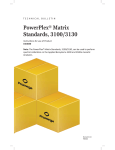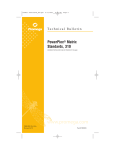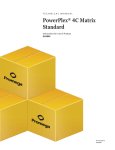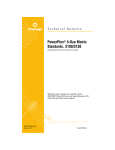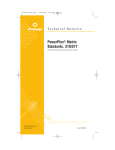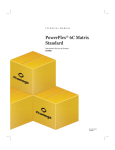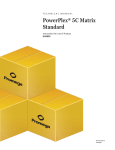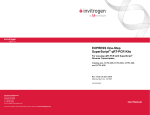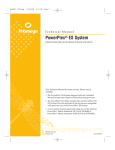Download PowerPlex® Matrix Standards, 3100/3130, Technical Bulletin
Transcript
TBD022.0406.qxp 8/10/2006 7:33 AM Page a Technical Bulletin PowerPlex® Matrix Standards, 3100/3130 INSTRUCTIONS FOR USE OF PRODUCT DG4650. IMPORTANT We recommend using this product once and then discarding it. PRINTED IN USA. 4/06 Part# TBD022 AF9TBD022 0406TBD022 TBD022.0406.qxp 8/10/2006 7:33 AM Page 1 PowerPlex® Matrix Standards, 3100/3130 All technical literature is available on the Internet at: www.promega.com/tbs/ Please visit the web site to verify that you are using the most current version of this Technical Bulletin. Please contact Promega Technical Services if you have questions on use of this system. E-mail [email protected]. I. Description..........................................................................................................1 II. Product Components and Storage Conditions ............................................2 III. Instrument Preparation and Spectral Calibration Using Data Collection Software, Version 2.0 or Version 3.0 (ABI PRISM® 3100, 3100-Avant, 3130 and 3130xl Genetic Analyzers)...............................................................2 A. Matrix Sample Preparation.................................................................................3 B. Instrument Preparation .......................................................................................3 IV. PowerPlex® Spectral Calibration File Generation Using Data Collection Software Version 1.0.1 or Version 1.1 (ABI PRISM® 3100 and 3100-Avant Genetic Analyzers)...............................................................5 A. B. C. D. E. F. Spectral Run Module ...........................................................................................5 Spectral Parameters..............................................................................................6 Matrix Sample Preparation.................................................................................6 Instrument Preparation .......................................................................................7 Spectral Calibration Run .....................................................................................8 Spectral Calibration Results................................................................................8 V. Troubleshooting.................................................................................................9 VI. Related Products ..............................................................................................10 I. Description Proper generation of a spectral calibration file is critical to evaluate multicolor systems with the ABI PRISM® 3100, 3100-Avant, 3130 and 3130xl Genetic Analyzers. The PowerPlex® Matrix Standards, 3100/3130, includes individual fragments labeled with four different fluorescent dyes. Each matrix fragment is in a separate tube: one tube contains a fragment labeled with fluorescein (FL), one tube contains a fragment labeled with 6-carboxy-4´,5´-dichloro-2´,7´dimethoxyfluorescein (JOE), one tube contains a fragment labeled with carboxy-tetramethylrhodamine (TMR), and one tube contains a fragment labeled with carboxy-X-rhodamine (CXR). These matrix fragments are mixed and used on the ABI PRISM® 3100, 3100Avant, 3130 or 3130xl Genetic Analyzer to perform a spectral calibration on a specified dye set. For data collection software Versions 1.0.1 and 1.1, the spectral Promega Corporation · 2800 Woods Hollow Road · Madison, WI 53711-5399 USA Toll Free in USA 800-356-9526 · Phone 608-274-4330 · Fax 608-277-2516 · www.promega.com Printed in USA. 4/06 Part# TBD022 Page 1 TBD022.0406.qxp 8/10/2006 7:33 AM Page 2 calibration should be performed on dye set Z using dye set F parameters. For data collection software Version 2.0 or 3.0, the spectral calibration should be performed on dye set F. Once generated, this file is applied during sample detection to calculate the spectral overlap between the four different dye colors. A matrix should be generated for each individual instrument. The PowerPlex® Matrix Standards, 3100/3130, was developed for use with the PowerPlex® 16(a,b,c), Y(a) and ES(a) Systems and can also be used with any of the GenePrint ® Fluorescent STR Systems(a). A matrix should be generated for each individual instrument. Protocols for operation of the ABI PRISM® 3100, 3100-Avant, 3130 or 3130xl Genetic Analyzer should be obtained from the manufacturer. Technical Manuals and additional product information are available upon request from Promega or on the Internet at: www.promega.com. II. Product Components and Storage Conditions Product PowerPlex® Matrix Standards 3100/3130 Not for Medical Diagnostic Use. Includes: • • • • • 25µl 25µl 25µl 25µl 1.25ml Cat. # DG4650 Fluorescein Matrix JOE Matrix TMR Matrix CXR Matrix Nuclease-Free Water Storage Conditions: Store all components at –20°C in a non frost-free freezer. The fragments in the matrix standards are light-sensitive and must be stored in the dark. We strongly recommend that these be stored with post-amplification reagents and used separately with different pipettes, tube racks, etc. We recommend using this product once and then discarding it. III. Instrument Preparation and Spectral Calibration Using Data Collection Software, Version 2.0 or Version 3.0 (ABI PRISM® 3100, 3100-Avant, 3130 and 3130xl Genetic Analyzers) Materials to Be Supplied by the User • Hi-Di™ formamide (Applied Biosystems Cat.# 4311320) • dry heating block, water bath or thermal cycler • crushed ice or an ice-water bath • 3100 or 3130 capillary array, 36cm • Performance Optimized Polymer 4 (POP-4™) for the 3100 or 3130 • 10X genetic analyzer buffer with EDTA • MicroAmp® optical 96-well plate • aerosol-resistant pipette tips Promega Corporation · 2800 Woods Hollow Road · Madison, WI 53711-5399 USA Toll Free in USA 800-356-9526 · Phone 608-274-4330 · Fax 608-277-2516 · www.promega.com Part# TBD022 Page 2 Printed in USA. 4/06 TBD022.0406.qxp 8/10/2006 7:33 AM Page 3 III.A. Matrix Sample Preparation There will be instrument-to-instrument variation in the sensitivity of detection. Matrix sample dilutions described here may need to be optimized in individual laboratories depending on the sensitivity of each ABI PRISM® 3100, 3100-Avant, 3130 or 3130xl Genetic Analyzer. 1. Thaw the concentrated matrix reagents. Mix the reagents by vortexing to 5–10 seconds before each use. Do not centrifuge the matrix reagents as this may cause the DNA to be concentrated at the bottom of the tube. 2. Initial dilution of concentrated fragments: Before mixing the dye fragments, dilute an aliquot of each dye fragment 1:10 in Nuclease-Free Water. Vortex 5–10 seconds to mix. Concentrated Dye Nuclease-Free Water JOE 5µl 45µl FL 5µl 45µl TMR 5µl 45µl CXR 5µl 45µl 3. Fragment mix (using 1:10 dilutions of dye fragments): After the initial dilution in Step 2, mix the dye fragments as listed below. Vortex each dye fragment before adding it to the HiDi™ formamide. Component Hi-Di™ formamide JOE from initial dilution FL from initial dilution TMR from initial dilution CXR from initial dilution Volume 480µl 5.0µl 5.0µl 5.0µl 5.0µl 4. On the ABI PRISM® 3100 and 3130xl Genetic Analyzer, 16 wells are used for matrix detection on 16 capillaries (wells A1 through H2 of a 96-well tray). Vortex and load 25µl of the fragment mix prepared in Step 3 into each of the 16 wells. On the ABI PRISM® 3100-Avant or 3130 Genetic Analyzer, four wells are used for matrix detection on the four capillaries (wells A1 through D1 in a 96-well plate). Load 25µl of the fragment mix into each of the four wells. 5. Denature samples at 95°C for 3 minutes, then immediately chill on crushed ice or in an ice-water bath for 3 minutes. Denature the samples just prior to loading the instrument. III.B. Instrument Preparation 1. Prepare the matrix samples as previously described in Section III.A. Note: You may need to dilute each matrix sample or adjust the injection time or voltage based on the sensitivity of your instrument. Peak heights in the range of 1,000–4,000RFU are ideal. Peak heights above 750RFU are required. Promega Corporation · 2800 Woods Hollow Road · Madison, WI 53711-5399 USA Toll Free in USA 800-356-9526 · Phone 608-274-4330 · Fax 608-277-2516 · www.promega.com Printed in USA. 4/06 Part# TBD022 Page 3 TBD022.0406.qxp 8/10/2006 7:33 AM Page 4 2. Run the spectral calibration procedure as described in the ABI PRISM® 3100, 3100-Avant, 3130 or 3130xl Genetic Analyzer User’s Manual with the following exceptions: a. In the “Module Manager,” select “New.” Select “Spectral” in the “Type” drop-down list, and select “Spect36_POP4” in the “Template” dropdown list. Confirm or change the following settings: Inj. kV: Inj. Secs: Data Delay Time: Run time: 3 5 100 800 seconds b. In the “Protocol Manager,”under Instrument Protocols select “New.” Type a name for your protocol. Select "Spectral" in the “Type” dropdown list, select “F” in the “DyeSet” drop-down list and select “36” in the “Array Length” drop-down list. Select the spectral module you created in the previous step in the “Run Module” drop-down list. Finally, select “Edit Parameters.” Change the lower condition bound to 4.0, and change the upper condition bound to 12.0. Select “OK” in the “Edit Parameters” window, and select “OK” in the “Protocol Manager.” Note: The condition number (“C value”) obtained when generating a spectral calibration will vary with the instrument. After obtaining a spectral calibration that performs acceptably, the condition bounds range in the previous step may be narrowed to more critically evaluate C values for subsequent calibrations. c. In the “Plate Manager,” create a new plate record as described in the instrument user’s manual. In the dialog box that appears, select “Spectral Calibration” in the “Application” drop-down list, and select “96-well” as the plate type. Add entries in the owner and operator windows, name the plate and select “OK.” d. In the spectral calibration plate editor dialog box, place sample names in the appropriate cells. In the “Instrument Protocol” column, select the protocol you created in Step 2.b. Ensure that this information is present for each row that contains a sample name. Select “OK.” e. Run your plate as described in the instrument user’s manual. f. Upon completion of the run, check the status of the spectral run in the “Event Log” window. For the ABI PRISM® 3100 and 3130xl Genetic Analyzers, we recommend that a minimum of 12 of the 16 capillaries pass calibration. For the ABI PRISM® 3100-Avant and 3130 Genetic Analyzers, we recommend that a minimum of three of the four capillaries pass calibration. If fewer than the recommended numbers of capillaries pass, the spectral calibration should be repeated. Promega Corporation · 2800 Woods Hollow Road · Madison, WI 53711-5399 USA Toll Free in USA 800-356-9526 · Phone 608-274-4330 · Fax 608-277-2516 · www.promega.com Part# TBD022 Page 4 Printed in USA. 4/06 TBD022.0406.qxp 8/10/2006 7:33 AM Page 5 5789TA g. When repeating the spectral calibration run, samples in the same plate may be re-injected a few times. There will be instrument-to-instrument variation in the sensitivity of detection; it may necessary to adjust the module injection voltage and/or the injection time. Figure 1. PowerPlex® Matrix Standards, 3100/3130 on the ABI PRISM® 3130 Genetic Analyzer using Foundation Data Collection Version 3.0. Figure is of the Red, Yellow, Blue and Green peaks in the raw data profile from each of the four capillaries in the Capillaries Viewer. Promega Corporation · 2800 Woods Hollow Road · Madison, WI 53711-5399 USA Toll Free in USA 800-356-9526 · Phone 608-274-4330 · Fax 608-277-2516 · www.promega.com Printed in USA. 4/06 Part# TBD022 Page 5 TBD022.0406.qxp 8/10/2006 7:33 AM Page 6 IV. PowerPlex® Spectral Calibration File Generation Using Data Collection Software, Version 1.0.1 or Version 1.1 (ABI PRISM® 3100 and 3100-Avant Genetic Analyzers) Note: To create a successful spectral calibration, two file modifications must be made; the first involves the run module, and the second involves the parameter file. These instructions only apply to the data collection software, Versions 1.0.1 and 1.1. For instructions to generate a spectral calibration using the data collection software, Version 2.0 or 3.0, see Section III. Materials to Be Supplied by the User • Hi-Di™ formamide (Applied Biosystems Cat.# 4311320) • dry heating block, water bath or thermal cycler • crushed ice or an ice-water bath • 3100 capillary array, 36cm • Performance Optimized Polymer 4 (POP-4™) for the 3100 instruments • 10X genetic analyzer buffer with EDTA • MicroAmp® optical 96-well plate • aerosol-resistant pipette tips IV.A. Spectral Run Module 1. Open the ABI PRISM® 3100 data collection software. 2. Under Tools, open the module editor. Select the calibration tab, and then select the “Spect36_POP4DefaultModule” module. 3. Confirm or change the settings for the following: Inj. kV: Inj. Secs: Data Delay Time: Run time: 3 5 100 800 seconds 4. Select “Save As” and save the module as a new name (for example, Spect36_POP4PowerPlex). Use this as the initial run module for all spectral calibration runs using the PowerPlex® Matrix Standards, 3100/3130. Note: There will be instrument-to-instrument variation in the sensitivity of detection. The injection times and voltage may have to be modified, depending on the sensitivity of each ABI PRISM® 3100 or 3100-Avant Genetic Analyzer. Promega Corporation · 2800 Woods Hollow Road · Madison, WI 53711-5399 USA Toll Free in USA 800-356-9526 · Phone 608-274-4330 · Fax 608-277-2516 · www.promega.com Part# TBD022 Page 6 Printed in USA. 4/06 TBD022.0406.qxp 8/10/2006 7:33 AM Page 7 IV.B. Spectral Parameters 1. To customize the spectral parameters, locate the parameter file at: My Computer/3100files (D:)\AppliedBio\Support Files\Data Collection Support Files\Calibration Data\Spectral Calibration\ParamFiles 2. Select “MtxStd{Genescan_SetF}”. This will open the “.par” file in Microsoft® Notepad. 3. Change the condition Bounds range to [4.0, 12.0] 4. Select “File Save As” to save the parameter file as a new name (for example, MtxStd{Genescan_ SetZPowerPlex}.par). Use this as the parameter file for all spectral calibration runs using the PowerPlex® Matrix Standards, 3100/3130. Note: The condition number (“C value”) obtained when generating a spectral calibration will vary with the instrument. After obtaining a spectral calibration that performs acceptably, the condition bounds range in the previous step may be narrowed to more critically evaluate C values for subsequent calibrations. IV.C. Matrix Sample Preparation There will be instrument-to-instrument variation in the sensitivity of detection. You may need to dilute each matrix sample or adjust the injection time or voltage depending on the sensitivity or each ABI PRISM® 3100 or 3100-Avant Genetic Analyzer. Peak heights in the range of 1,000–4,000RFU are ideal. Peak heights above 750RFU are required. 1. Thaw the concentrated matrix reagents. Mix the reagents by vortexing to 5–10 seconds before each use. Do not centrifuge the matrix reagents as this may cause the DNA to be concentrated at the bottom of the tube. 2. Initial dilution of concentrated fragments: Before mixing the dye fragments, dilute an aliquot of each dye fragment 1:10 in Nuclease-Free Water. Vortex to mix. Concentrated Dye Nuclease-Free Water JOE 5µl 45µl FL 5µl 45µl TMR 5µl 45µl CXR 5µl 45µl Promega Corporation · 2800 Woods Hollow Road · Madison, WI 53711-5399 USA Toll Free in USA 800-356-9526 · Phone 608-274-4330 · Fax 608-277-2516 · www.promega.com Printed in USA. 4/06 Part# TBD022 Page 7 TBD022.0406.qxp 8/10/2006 7:33 AM Page 8 3. Fragment mix (using 1:10 dilutions of dye fragments): After the initial dilution in Step 2, mix the dye fragments as listed below. Vortex each dye fragment before adding it to the HiDi™ formamide. Component Hi-Di™ formamide JOE from initial dilution FL from initial dilution TMR from initial dilution CXR from initial dilution Volume 480µl 5.0µl 5.0µl 5.0µl 5.0µl 4. On the ABI PRISM® 3100 Genetic Analyzer, 16 wells are used for matrix detection on 16 capillaries (wells A1 through H2 of a 96-well tray). Vortex and load 25µl of the fragment mix prepared in Step 3 into each of the 16 wells. On the ABI PRISM® 3100-Avant Genetic Analyzer, four wells are used for matrix detection on the four capillaries (wells A1 through D1 in a 96-well plate). 5. Denature samples at 95°C for 3 minutes, then chill immediately on crushed ice or in an ice-water bath for 3 minutes. Denature the samples just prior to loading the instrument. IV.D. Instrument Preparation These instructions apply only when using the data collection software, Version 1.0.1 or 1.1. 1. Refer to the instrument user’s manual for instructions on cleaning the pump blocks, installing the capillary array, performing a spectral calibration and adding polymer to the reserve syringe. 2. Open the ABI PRISM® 3100 data collection software. 3. Open a new plate record. Name the plate, and select “Spectral Calibration”. Select “96-well” as the plate type. Select “Finish”. 4. Complete the plate record spreadsheet for the wells you have loaded. Enter appropriate information into the “Sample Name” column. 5. In the dye set column, select “Z” from the pull-down menu. 6. In the spectral run module column, select “Spect36_POP4PowerPlex” from the pull-down menu. This is the module that was created in Section IV.A. Promega Corporation · 2800 Woods Hollow Road · Madison, WI 53711-5399 USA Toll Free in USA 800-356-9526 · Phone 608-274-4330 · Fax 608-277-2516 · www.promega.com Part# TBD022 Page 8 Printed in USA. 4/06 TBD022.0406.qxp 8/10/2006 7:33 AM Page 9 7. In the spectral parameters column, select “mtxStd{Genescan_SetZ PowerPlex}” from the pull-down menu. This is the file that was created in Section IV.B. The resulting spectral plate record should have the following settings: Dye Set: Spectral Run Module: Spectral Parameters: Z Spect36_POP4PowerPlex MtxStd{Genescan_SetZPowerPlex} 8. Select “OK”. This new plate record will appear in the pending plate records table on the plate setup page of the data collection software. IV.E. Spectral Calibration Run 1. In the pending plate records table, click once on the name of the plate record you just created. 2. Once the plate record is highlighted, select the plate graphic that corresponds to the plate on the autosampler that contains your spectral calibration samples. 3. When the plate record is linked to the plate, the plate graphic will change from yellow to green, the plate record moves from the pending plate records table to the linked plate records table, and the “Run Instrument” button becomes enabled. 4. Select the “Run Instrument” button on the toolbar to start the spectral calibration run. IV.F. Spectral Calibration Results 1. After the spectral calibration run is completed, the “Spectral Calibration Result” window opens, indicating which capillaries passed calibration. A “.” indicates the capillary passed. An “X” indicates the capillary failed. 2. Select “OK”. 3. Review the spectral calibration data. In the tools menu of the data collection software, select “Display Spectral Calibration”. 4. Select the dye set button, select “Dye Set Z” from the pull-down menu and select “OK”. 5. The “Matrices for Dye Set Z” window displays the spectral calibration data for each capillary. Use the scroll bar to review the data for each of the 16 capillaries. For the PowerPlex® Matrix Standards, 3100/3130, the following conditions must be met for the capillary to pass calibration: a. The Q-value must be greater than 0.95. b. The condition number (or C-value) must fall within the range previously determined in Section IV.B, Step 3. c. The peak height values must be above 750rfu and below saturation. Promega Corporation · 2800 Woods Hollow Road · Madison, WI 53711-5399 USA Toll Free in USA 800-356-9526 · Phone 608-274-4330 · Fax 608-277-2516 · www.promega.com Printed in USA. 4/06 Part# TBD022 Page 9 TBD022.0406.qxp 8/10/2006 7:33 AM Page 10 6. Select “OK” to close the window. 7. If a capillary fails calibration, it will automatically be assigned the spectral data from the nearest passing capillary to the left. To achieve an effective spectral calibration file, we recommend that a minimum of 12 out of the 16 capillaries pass calibration for the ABI PRISM® 3100 Genetic Analyzer. For the ABI PRISM® 3100-Avant Genetic Analyzer, we recommend that a minimum of three of the four capillaries pass calibration. If fewer than the recommended number of capillaries pass, the spectral calibration should be repeated. 8. When repeating the spectral calibration run, samples in the same plate may be re-injected a few times. There will be instrument-to-instrument variation in the sensitivity of detection; it may be necessary to adjust the module injection voltage and/or the injection time. V. Troubleshooting For questions not addressed here, please contact your local Promega Branch Office or Distributor. Contact information available at: www.promega.com. E-mail: [email protected] Symptoms Causes and Comments Fewer than the recommended number of capillaries pass the spectral calibration Matrix standards are too dilute. Matrix samples that are too dilute will result in low peak heights. If the matrix peak heights are below 1,000RFU, decrease the dilution of each fragment in Step 2 of Section III.A or IV.C. Matrix standards are too concentrated. Matrix sample peak heights that are too high may result in bleedthrough or oversubtraction in other dye colors, which may result in spectral calibration failure. If matrix sample peak heights are too intense (>6,000RFU), increase the dilution of each fragment in Step 2 of Section III.C or IV.A and repeat the spectral calibration run. Another option is to decrease the injection time, so less sample is injected. Promega Corporation · 2800 Woods Hollow Road · Madison, WI 53711-5399 USA Toll Free in USA 800-356-9526 · Phone 608-274-4330 · Fax 608-277-2516 · www.promega.com Part# TBD022 Page 10 Printed in USA. 4/06 TBD022.0406.qxp 8/10/2006 7:33 AM Page 11 VI. Related Products Product PowerPlex® 16 System PowerPlex® Y System PowerPlex® 1.2 System PowerPlex® ES System Size 100 reactions 400 reactions 50 reactions 200 reactions 100 reactions 100 reactions 400 reactions Cat. # DC6531 DC6530 DC6761 DC6760 DC6101 DC6731 DC6730 Size 50ml Cat. # P1193 Not for Medical Diagnostic Use. Accessory Components Product Nuclease-Free Water For Laboratory Use. Promega Corporation · 2800 Woods Hollow Road · Madison, WI 53711-5399 USA Toll Free in USA 800-356-9526 · Phone 608-274-4330 · Fax 608-277-2516 · www.promega.com Printed in USA. 1/06 Part# TBD022 Page 11 TBD022.0406.qxp 8/10/2006 7:33 AM Page 12 (a) STR loci are the subject of U.S. Pat. No. RE 37,984, German Pat. No. DE 38 34 636 C2 and other patents issued to the MaxPlanck-Gesellschaft zur Förderung der Wissenschaften, e.V., Germany. The development and use of STR loci are covered by U.S. Pat. No. 5,364,759, Australian Pat. No. 670231 and other pending patents assigned to Baylor College of Medicine, Houston, Texas. Use of Promega’s STR Systems requires performance of the polymerase chain reaction (PCR), which is the subject of European Pat. Nos. 201,184 and 200,362 and U.S. Pat. Nos. 4,683,195, 4,965,188 and 4,683,202 owned by Hoffmann-La Roche*. Purchase of Promega’s STR Systems does not include or provide a license with respect to these patents or any other PCRrelated patent owned by Hoffmann-La Roche or others. Users of Promega’s STR Systems may, therefore, be required to obtain a patent license, depending on the country in which the systems are used. For more specific information on obtaining a PCR license, please contact Hoffmann-La Roche. *In the U.S., effective March 29, 2005, the above primary U.S. Pat. Nos. 4,683,195, 4,965,188 and 4,683,202 will expire. In Europe, effective March 28, 2006, the above primary European Pat. Nos. 201,184 and 200,362 will expire. (b)U.S. Pat. Nos. 6,238,863 and 6,767,703 have been issued to Promega Corporation for materials and methods for identifying and analyzing intermediate tandem repeat DNA markers. Other patents are pending. (c)U.S. Pat. Nos. 5,843,660, 6,479,235 and 6,221,598, Australian Pat. No. 724531, Canadian Pat. No. 2,118,048, Korean Pat. No. 290332, Singapore Pat. No. 57050 and Japanese Pat. No. 3602142 have been issued to Promega Corporation for multiplex amplification of STR loci. Other patents are pending. © 2006 Promega Corporation. All Rights Reserved. GenePrint and PowerPlex are registered trademarks of Promega Corporation. ABI PRISM and MicroAmp are registered trademarks of Applera Corporation. Hi-Di and POP-4 are trademarks of Applera Corporation. Microsoft is a registered trademark of Microsoft Corporation. All prices and specifications are subject to change without prior notice. Product claims are subject to change. Please contact Promega Technical Services or access the Promega online catalog for the most up-to-date information on Promega products. Promega Corporation · 2800 Woods Hollow Road · Madison, WI 53711-5399 USA Toll Free in USA 800-356-9526 · Phone 608-274-4330 · Fax 608-277-2516 · www.promega.com Part# TBD022 Page 12 Printed in USA. 4/06













